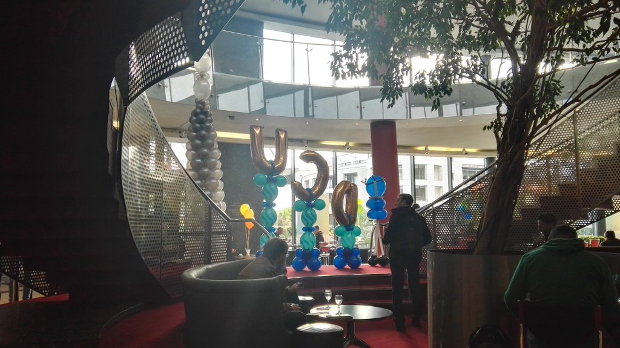The Faculty of Engineering and Computing Final Year Projects exposition has now, in one form or another, been around for nearly thirty years and the 2016 event saw 207 student projects viewed by more than 100 prospective employers.
This year’s crop saw a lot of apps, quite a few different pure engineering projects and some quite speculative endeavours.
Daire Keogh, deputy president, DCU, welcomed the attendees of the expo and acknowledged the “wonderful creativity in the projects”. That said, Keogh acknowledged that there was work to do on gender balance in the faculty, but even there, progress was noticeable over previous years.
“We believe that the final year projects on display here today reflect the great opportunities for these young graduates to contribute to the advancement of Irish society over the coming years,” Prof Barry McMullin, faculty of Engineering and Computing
The number of prospective employers attending, said Keogh, is a clear indicator of the power of the event to showcase the talents of the students, and get the message out of what is being achieved.
The creativity in the projects shows that many of the students are destined for great things, said Keogh.
Above all, Keogh encouraged students to “enjoy this”, highlighting the fact that the event is all about showing their talents in the best possible light.
Long time event sponsor SAP was represented by Aisling Mulholland, herself a participant in the expo a few years ago. She recalled the experience as “nerve-wracking”, but given her immediate graduation to a positon with SAP, Mulholland is entirely convinced of the value of the event.
Looking back from her current position, she acknowledged that while some students may have a clear idea of their career path, others may be less so. Irrespective, Mulholland encouraged the students to enjoy the journey, as she argued that this generation can lead the transformation of people’s lives through technology.
There was a strong IT theme among the projects, software-defined networking, IT management and Wi-Fi monitoring all featuring.
Ashley Deane developed a vendor-neutral system for managing software-defined networking, using the Spring framework. Conor Hughes’ project went after a slightly different audience by developing an IT infrastructure management system that can be used by the technical and non-technical. An early successful test was with his father who completed a set of tasks despite near-zero IT knowledge.
Eoin O’Brien’s social media sentiment monitoring system allows users to create custom filters to look for conversations and content related to brands, products or topics. Acknowledging that the accuracy of the algorithms is far from certain, the results still provide insights that support actions in the areas of customer support and relations.
Sam Skelton developed a cost-effective system for monitoring user movements in a building via the Wi-Fi network.
On the engineering side, Matthew Walsh used computer analysis and design to develop a more efficient exhaust system for a small four-stroke engine. Working with a lowly Starlet, he achieved 10% power gain through the use of effective modelling and flow control.
Alex Reilly was able to use computer modelling to evaluate various systems for steering in four-wheeled vehicles. Using modelling to test the various designs produced from formulas, he was able to determine the best one compared to the Ackerman Condition, which sets out the ideal track.
While numerous projects also focused on learning applications, from Irish language vocabulary to applications to aggregate and discern information from published material, what was most likely to appeal to school children was Kevin McGee’s self-balancing ball robot.
Echoing the BB8 character from the latest instalment in the Star Wars series, McGee developed a set of equations to control power, torque, sensing and directional controls, before creating a frame rig to test the hardware. McGee had to admit failure in terms of a fully working prototype, but only because his limited budget did not allow for a processing unit powerful enough to process in real-time. However, he was able to prove the efficacy of his programming and the overall principle.
“We believe that the final year projects on display here today reflect the great opportunities for these young graduates to contribute to the advancement of Irish society over the coming years. Many of the projects displayed represent products with immediate commercial potential: all demonstrate ingenuity, skill and technical ability of the highest calibre,” said Professor Barry McMullin, dean, faculty of Engineering and Computing.
TechCentral Reporters






Subscribers 0
Fans 0
Followers 0
Followers